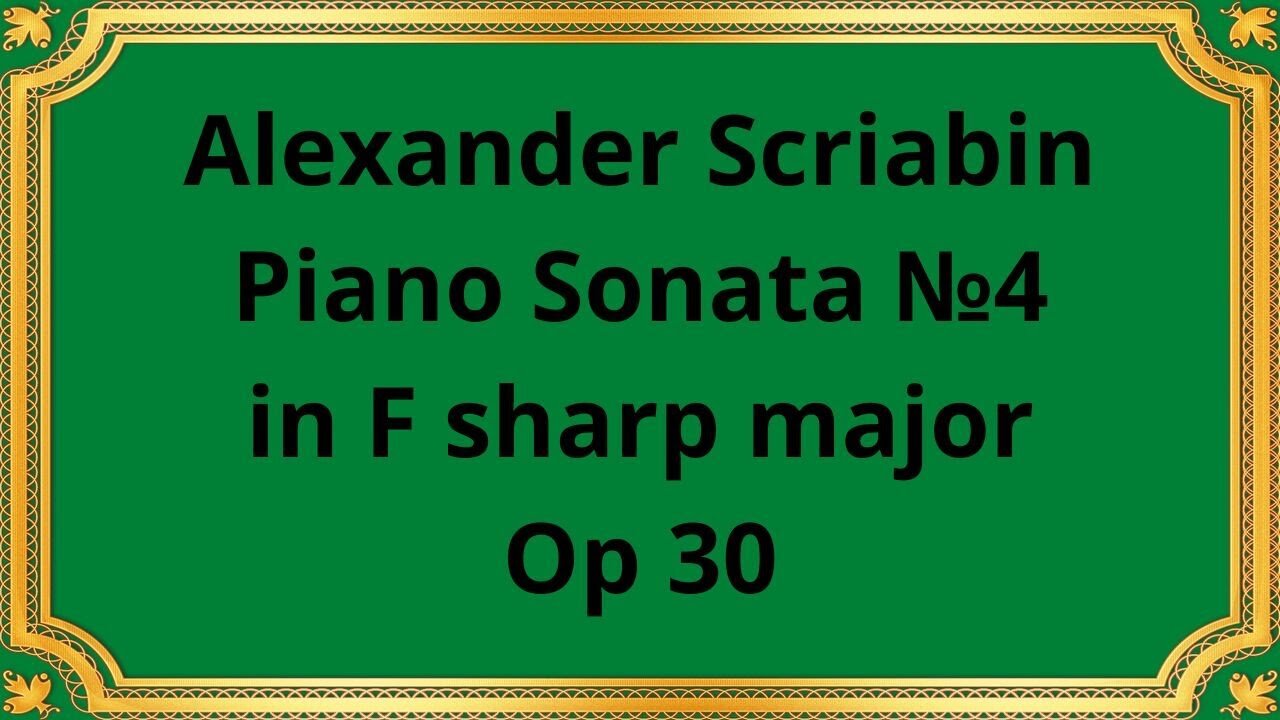Premium Only Content

Alexander Scriabin Piano Sonata №4 in F sharp major Op 30
#ClassicalMusic #Scriabin #PianoSonata #FSharpMajor #Op309 #MusicalComposition
Publication date 1937
Katherine Ruth Heyman (piano)
Alexander Scriabin, a renowned Russian composer and pianist, left an indelible mark on the world of classical music. Among his notable compositions, the Piano Sonata No. 4 in F sharp major Op. 30 stands as a testament to his innovation and emotional depth.
The Piano Sonata No. 4 was composed between 1903 and 1905, a time when Scriabin was transitioning from a more traditional style to a more experimental and expressive approach. This period marked a departure from the romantic era, with composers embracing new harmonic languages and pushing the boundaries of tonality.
The sonata follows a traditional three-movement structure: Allegro, Prestissimo volando, and Andante. The first movement introduces the main themes and explores contrasting tonalities, showcasing Scriabin's adeptness at chromatic harmonies. The second movement, known for its lightning-fast tempo, captivates listeners with its virtuosic passages and intense energy. The final movement, Andante, provides a serene and lyrical contrast, bringing a sense of resolution and tranquility.
Scriabin's Piano Sonata No. 4 is renowned for its unique harmonic language. The piece incorporates atonal elements, dissonance, and unconventional chord progressions, reflecting Scriabin's exploration of new tonal possibilities. The melodic lines are often intricate, combining sweeping romantic melodies with highly chromatic passages. This fusion of harmonies and melodies creates an ethereal and introspective atmosphere.
One distinctive aspect of Scriabin's music is his belief in the power of synesthesia, a condition where one sense triggers the perception of another. In the case of this sonata, Scriabin associated each movement with specific colors and emotions. The first movement is associated with white light and joy, the second with a dark blue hue and intense passion, and the final movement with golden light and a sense of tranquility. This unique approach adds an extra layer of depth and complexity to the composition.
Scriabin's Piano Sonata No. 4 is an embodiment of the composer's own emotional journey. It conveys a wide range of emotions, from euphoria and ecstasy to melancholy and introspection. The contrasting moods and expressive passages allow listeners to experience a profound emotional connection and evoke personal interpretations.
Alexander Scriabin's Piano Sonata No. 4 in F sharp major Op. 30 stands as a testament to his innovative spirit and emotional depth. Through its harmonic explorations, melodic intricacies, and synesthetic associations, the sonata offers a captivating musical experience. This piece showcases Scriabin's ability to push the boundaries of traditional composition while maintaining a deep emotional resonance. It continues to captivate audiences and holds a significant place in the realm of classical music.
You have the opportunity to support the channel:
https://destream.net/live/RadSiarAl/donate
https://www.buymeacoffee.com/6355radsiaral
-
 18:26
18:26
Classical music_Music Inspiration
1 month agoLudwig van Beethoven Piano Sonata No. 8 in C minor, Op. 13 "Pathétique"
601 -
 13:08
13:08
Dad Saves America
11 hours ago $0.01 earnedTeachers Unions Play Politics While Students Lag Behind - Poisoning of the American Mind: Pt 4
1024 -
 20:05
20:05
Preston Stewart
11 hours agoCrimea Raid to Chasiv Yar Fight
202 -
 8:11
8:11
Millionaire Mentor
13 hours agoTulsi Gabbard and Leavitt DOUBLE-TEAM Kaitlan Collins in FIERY Exchange
3.38K1 -
 46:02
46:02
Coin Stories with Natalie Brunell
1 day agoWhat They’re Hiding About the Economy | Natalie Brunell with Danielle DiMartino Booth
10.3K5 -
 12:12
12:12
GritsGG
12 hours ago23 Warzone Wins in a Row! (Cypher AR)
73.7K -
 2:12:07
2:12:07
Side Scrollers Podcast
19 hours agoCULTURE SHIFT CAUSES MELTDOWNS + MASSIVE CENSORSHIP EFFORTS RAMP UP | SIDE SCROLLERS LIVE
13.2K5 -
 11:25
11:25
Nikko Ortiz
1 day agoMost Painful Fails
48.4K28 -
 43:55
43:55
pewculture
6 days ago $3.57 earnedIf the Purge was real, this is what we'd do... - EP#24
16.8K5 -
 8:14
8:14
MattMorseTV
1 day ago $10.29 earnedTrump just DROPPED the HAMMER.
61.7K68